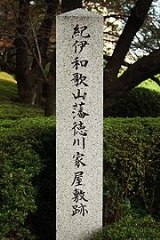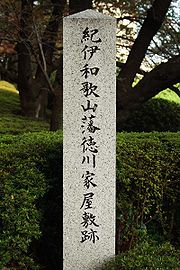
Wakayama Domain
Encyclopedia

Kii Province
, or , was a province of Japan in the part of Honshū that is today Wakayama Prefecture, as well as the southern part of Mie Prefecture. Kii bordered Ise, Izumi, Kawachi, Shima, and Yamato Provinces. The Kii Peninsula takes its name from this province....
(present-day Wakayama Prefecture
Wakayama Prefecture
is a prefecture of Japan located on the Kii Peninsula in the Kansai region on Honshū island. The capital is the city of Wakayama.- History :Present-day Wakayama is mostly the western part of the province of Kii.- 1953 Wakayama Prefecture flood disaster :...
and southern Mie Prefecture
Mie Prefecture
is a prefecture of Japan which is part of the Kansai regions on Honshū island. The capital is the city of Tsu.- History :Until the Meiji Restoration, Mie prefecture was known as Ise Province and Iga Province....
), with income of 555,000 koku
Koku
The is a Japanese unit of volume, equal to ten cubic shaku. In this definition, 3.5937 koku equal one cubic metre, i.e. 1 koku is approximately 278.3 litres. The koku was originally defined as a quantity of rice, historically defined as enough rice to feed one person for one year...
. The domain was also known as or . The heads of the domain were Kishu-Tokugawa clan, one of Gosanke
Gosanke
The , also called simply Gosanke or even Sanke, were three branches of the Tokugawa clan of Japan descended from clan founder Tokugawa Ieyasu's three youngest sons, Yoshinao, Yorinobu and Yorifusa and allowed to provide a shogun in case of need. The three houses were called Owari House of Tokugawa,...
. The domain was founded by Tokugawa Yorinobu
Tokugawa Yorinobu
was a Japanese daimyo of the early Edo period.Born under the name Nagafukumaru, he was the 10th son of Tokugawa Ieyasu, by his concubine Oman-no-kata. On December 8, 1603, Yorinobu received the fief of Mito, then rated at 200,000 koku, as his fief. Mito had formerly belonged to his older brother,...
, tenth son of shogun Tokugawa Ieyasu
Tokugawa Ieyasu
was the founder and first shogun of the Tokugawa shogunate of Japan , which ruled from the Battle of Sekigahara in 1600 until the Meiji Restoration in 1868. Ieyasu seized power in 1600, received appointment as shogun in 1603, abdicated from office in 1605, but...
, when he moved from Sunpu Domain
Sunpu Domain
' was a Japanese feudal domain intermittently during the Edo period. It was centered in Suruga Province, in what is now the city of Shizuoka, but at times included Kai and parts of Tōtōmi Provinces. In 1869 the domain was renamed .-History:...
in Suruga Province
Suruga Province
was an old province in the area that is today the central part of Shizuoka prefecture. It was sometimes called . Suruga bordered on Izu, Kai, Sagami, Shinano, and Tōtōmi provinces; and had access to the Pacific Ocean through Suruga Bay.-History:...
to Kii Province.
Heads
Kishu-Tokugawa (ShinpanShinpan (daimyo)
The daimyo were certain relatives of the Tokugawa shoguns of Japan. While all shinpan were relatives of the shogun, not all relatives of the shogun were shinpan; an example of this is the Matsudaira clan of the Okutono Domain. The shinpan lords were also known as kamon daimyō — non-daimyo...
)
- YorinobuTokugawa Yorinobuwas a Japanese daimyo of the early Edo period.Born under the name Nagafukumaru, he was the 10th son of Tokugawa Ieyasu, by his concubine Oman-no-kata. On December 8, 1603, Yorinobu received the fief of Mito, then rated at 200,000 koku, as his fief. Mito had formerly belonged to his older brother,...
- founder - MitsusadaTokugawa Mitsusadawas a daimyo in Japan during the Edo period . He was the son and heir of Tokugawa Yorinobu and a grandson of Tokugawa Ieyasu; among his sons was the eighth Tokugawa shogun Yoshimune. A daughter of his married Ichijō Kaneteru....
- Tsunanori
- Yorimoto
- YoshimuneTokugawa Yoshimunewas the eighth shogun of the Tokugawa shogunate of Japan, ruling from 1716 until his abdication in 1745. He was the son of Tokugawa Mitsusada, the grandson of Tokugawa Yorinobu, and the great-grandson of Tokugawa Ieyasu.-Lineage:...
- later became shogun - Munenao
- MunemasaTokugawa Munemasawas a Japanese daimyo of the mid-Edo period, who ruled the Wakayama Domain.-References:...
- Shigenori
- Harusada
- Harutomi
- Nariyuki
- Narikatsu
- Yoshitomi (later became shogun IemochiTokugawa Iemochiwas the 14th shogun of the Tokugawa shogunate of Japan, who held office 1858 to 1866. During his reign there was much internal turmoil as a result of Japan's first major contact with the United States, which occurred under Commodore Perry in 1853 and 1854, and of the subsequent "re-opening" of...
) - Mochitsugu

